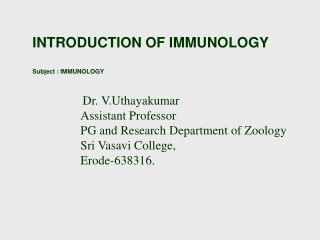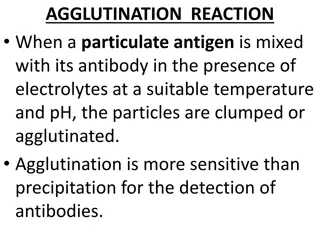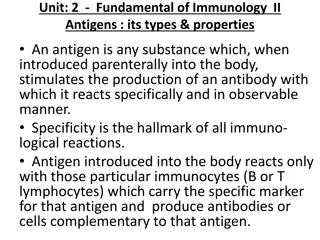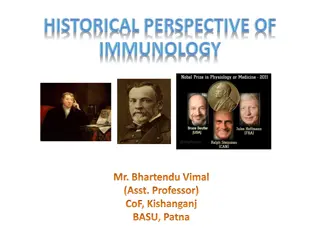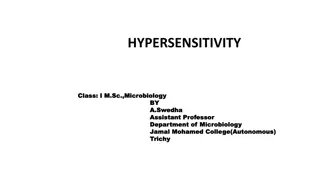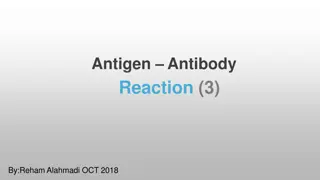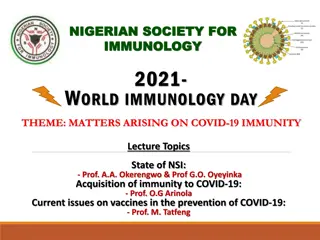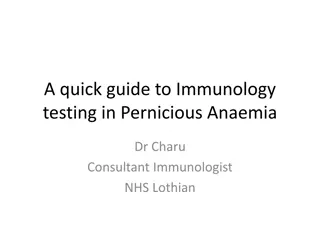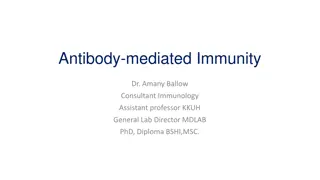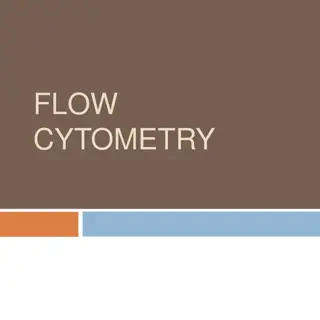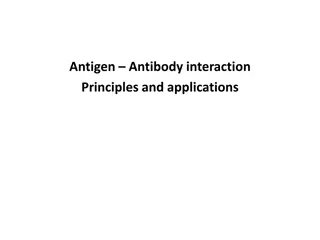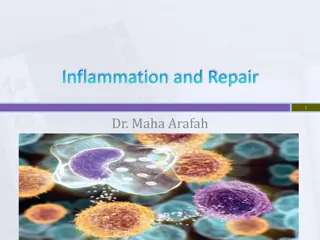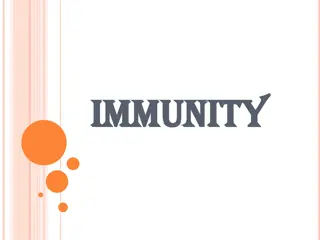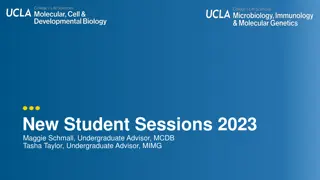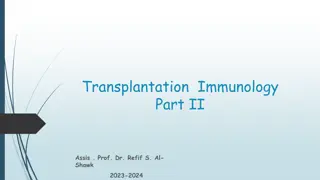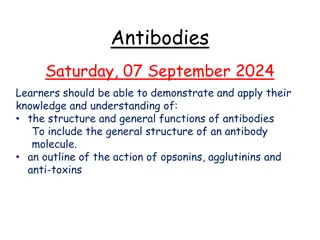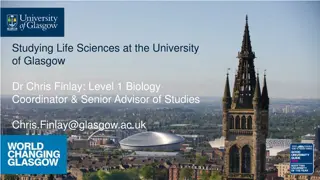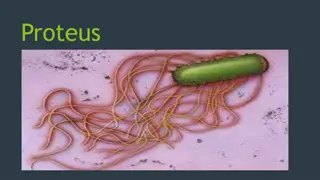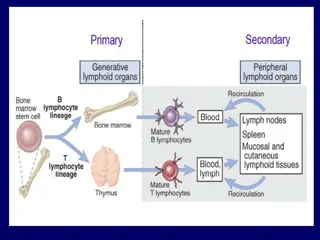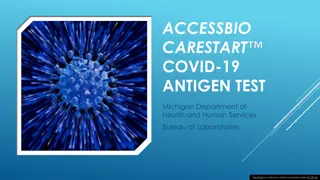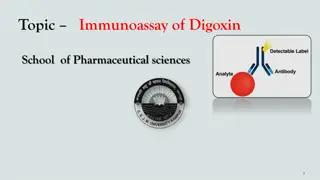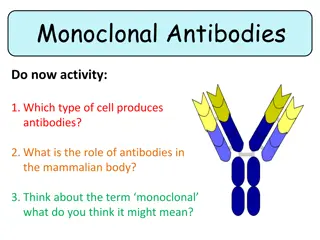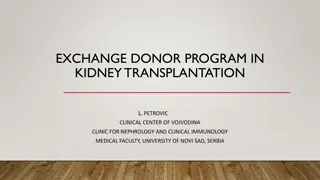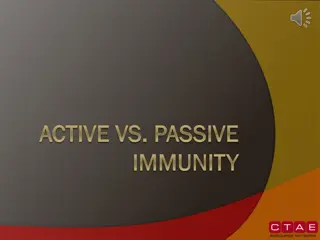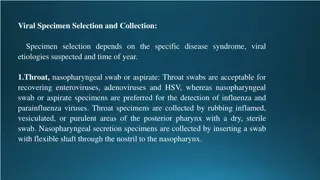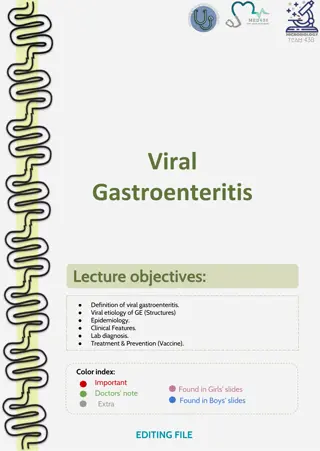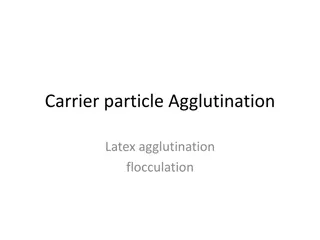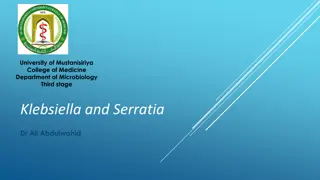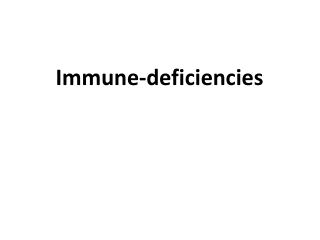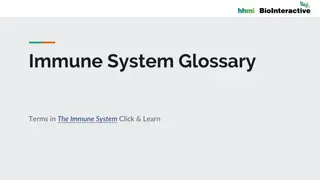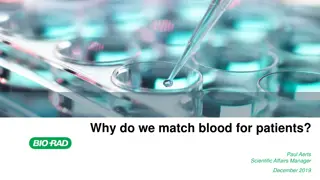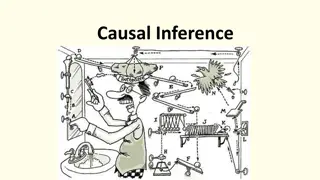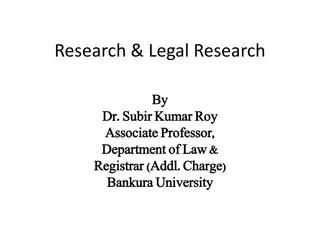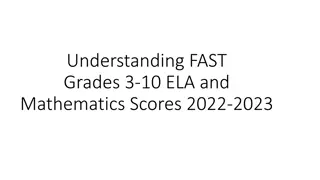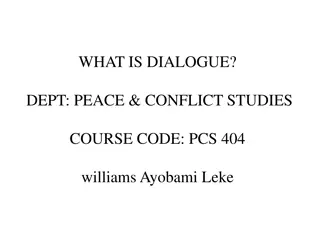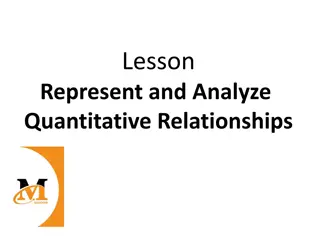Understanding Antigens and Immunogenicity in Immunology
Learn about antigens, immunogenicity, antigenicity, and epitopes in immunology. Antigens are substances with distinct immunologic properties, while immunogenicity refers to the ability of an antigen to induce an immune response. Antigenicity is the ability of an antigen to combine specifically with antibodies or T cell receptors. Epitopes are the smallest units of antigenicity, with sequential and conformational types. Haptens are small molecules with immunological reactivity but lacking immunogenicity. Explore the factors influencing immunogenicity and the biological classes of antigens in this informative session.
Download Presentation

Please find below an Image/Link to download the presentation.
The content on the website is provided AS IS for your information and personal use only. It may not be sold, licensed, or shared on other websites without obtaining consent from the author. Download presentation by click this link. If you encounter any issues during the download, it is possible that the publisher has removed the file from their server.
E N D
Presentation Transcript
Learning objectives By the end of this session student should be able to know Definition of antigen Factors influencing immunogenicity Biological classes of antigens
ANTIGEN Defined as any substance that satisfies two distinct immunologic properties- oImmunogenicity oAntigenicity.
Immunogenicity Ability of an antigen to induce immune response in the body (both humoral and/or cell mediated). oB cells + antigen effector B cells (plasma cell) + memory B cells oT cells + antigen effector T cells (helper T cell or cytotoxic T cell) + memory T cells Substance that satisfies this property i.e. immunogenicity - more appropriately called as immunogen rather than antigen .
Antigenicity (immunological reactivity) Ability of an antigen to combine specifically with the final products antibodies and/or T cell-surface receptors. All molecules having immunogenicity property, also show antigenicity, but the reverse is not true o E.g. Haptens- which are antigenic but not immunogenic.
Epitope or antigenic determinant Smallest unit of antigenicity. Definition - Small area present on the antigen comprising of few (four to five) amino acids or monosaccharide residues, that is capable of sensitizing T and B cells and reacting with specific site of T cell receptor or an antibody. Specific site of an antibody that reacts with the corresponding epitope of an antigen is called as paratope.
Types of epitope Sequential or linear epitope- Present as a single linear sequence of few amino acid residues. Conformational or non sequential epitopes o Found on the flexible region of complex antigens having tertiary structures. o Formed by bringing together the surface residues from different sites of the peptide chain during its folding into tertiary structure. T cells recognize sequential epitopes, while B cells bind to the conformational epitopes.
HAPTENS Low molecular weight molecules that lack immunogenicity (cannot induce immune response) but retain antigenicity or immunological reactivity (i.e. can bind to their specific antibody or T cell receptor). Haptens can become immunogenic when combined with a larger protein molecule called carrier . The hapten-carrier complex is capable of inducing immune response in the body.
HAPTENS It is observed that animals immunized with such a hapten-carrier conjugate produce antibodies specific for- oEpitopes of hapten oUnaltered epitopes on the carrier protein & oNew epitopes formed by combined parts of both the hapten and carrier.
Haptens - Classification Complex haptens: o Contain two or more epitopes. Simple haptens: o Contain only one epitope (univalent).
ANTIGEN AND HOST RELATIONSHIP Based on the antigen-host relationship, antigens can be grouped into two groups: o Self or auto antigens o Non-self or foreign antigens
Self or auto antigens Belong to the host itself - not immunogenic. Hosts do not react to their own antigens by exhibiting a mechanism called immunological tolerance. Sometimes, the self-antigens are biologically altered (e.g. as in cancer cells) and can become immunogenic.
Non-self or foreign antigens- Immunogenic and are of three types based on their phylogenetic distance to the host. o Alloantigens are species specific. Tissues of all individuals in a species contain species-specific antigens. o Isoantigens are type of antigens which are present only in subsets of a species, e.g. blood group antigens and histocompatibility antigens. The histocompatibility antigens are highly specific as they are unique to every individual of a species. o Heteroantigens Antigens belonging to two different species are called as heteroantigens, e.g. antigens of plant or animal or microorganisms etc.
Heterophile antigens Heterophile antigens - are a type of heteroantigens that are present in two different species; but they share epitopes with each other.
Diagnostic application- Heterophile antigens Weil- Felix reaction Paul-Bunnell test Cold agglutination test and Streptococcus MG test
FACTORS INFLUENCING IMMUNOGENICITY Size of the antigen Chemical nature of the antigen Susceptibility of antigen to tissue enzymes Structural complexity Foreignness to the host Genetic factor Optimal dose of antigen Route of antigen administration Repeated Number of doses of antigens Multiple antigens Effect of prior administration of antibody
Size of the antigen Larger is the size; more potent is the molecule as an immunogen. Molecules of > 10,000 Dalton molecular weight only can induce immune response
Chemical nature of the antigen Proteins are stronger immunogens than carbohydrates followed by lipid and nucleic acids.
Susceptibility of antigen to tissue enzymes Only substances that are susceptible to the action of tissue enzymes are immunogenic. Degradation of the antigen by the tissue enzymes produces several immunogenic fragments having more number of epitopes exposed.
Structural complexity Simple homopolymers made up of single amino acid lack immunogenicity. Polymers made up of two or more amino acids are immunogenic. Addition of aromatic amino acids increases immunogenicity.
Foreignness to the host Key factor which determines immunogenicity. Higher is the phylogenetic distance between the antigen and the host; more is the immunogenicity.
Genetic factor Different individuals of a given species show different types of immune responses towards the same antigen. o Responders- are the individuals who produce antibody faster o Slow responders- are the individuals who produce antibody slowly and may need repeated antigenic exposures o Non-responders - are the individuals who do not produce antibody in spite of repeated antigenic exposures.
Optimal dose of antigen An antigen is immunologically active only in the optimal dose range.
Route of antigen administration Immune response is better induced following parenteral administration of an antigen. Site of injection may influence immunogenicity:
Repeated doses of antigens Repeated doses of antigens over a period of time are needed to generate an adequate immune response. This is due to the role of memory cells in secondary immune response. However, after a certain doses of antigens, no further increase in antibody response is seen.
Multiple antigens When two or more antigens are administered simultaneously, the effects may vary. Antibody response to one or the other antigen may be equal or diminished (due to antigenic competition) or enhanced (due to adjuvant like action).
Adjuvant Any substance that enhances the immunogenicity of an antigen. Added to vaccines to increase the immunogenicity of the vaccine antigen.
Adjuvants o Alum (aluminium hydroxide or phosphate) o Mineral oil (liquid paraffin) o Freund's incomplete adjuvant- It is a water-in-oil emulsion containing a protein antigen in the aqueous phase. o Freund's complete adjuvant is the mixture of Freund's incomplete adjuvant & suspension of killed tubercle bacilli in the oil phase. o Lipopolysaccharide (LPS) fraction of Gram-negative bacilli o Other bacteria or their products- Mycobacterium bovis Toxoid (diphtheria toxoid and tetanus toxoid act as adjuvant for Haemophilus influenzae-b vaccine) o Nonbacterial products: Silica particles, beryllium sulfate, squalene, and thimerosal.
Mechanism of adjuvant action Delaying the release of antigen By activating phagocytosis By activating TH cells By granuloma formation
Effect of prior administration of antibody Primary immune response is more susceptible to get suppressed than the secondary immune response. Therapeutic application o In Rh negative women carrying an Rh positive fetus, the anti-Rh globulin is administrated immediately following delivery (within 72 hours) which prevents the Rh sensitization in Rh negative women by a negative feedback mechanism.
BIOLOGICAL CLASSES OF ANTIGENS Depending on the mechanisms of inducing antibody formation, antigens are classified as: o T cell dependent (TD) antigens. o T cell independent (TI) antigens.
T-dependent (TD) Antigens Most of the normal antigens are T cell dependent, they are processed and presented by antigen- presenting cells (APCs) to T cells which leads to T cell activation. Activated T cells secrete cytokines that in turn stimulate the B cells to produce antibodies.
T-independent (TI) Antigens Antigens such as bacterial capsule, flagella and LPS (lipopolysaccharide) that do not need the help of T cells and APCs. Directly bind to immunoglobulin receptors present on B cells and stimulate B cells polyclonally. Leads to increased secretion of non- specific antibodies (hypergamma-globulinemia). TI antigens can activate both mature and immature B cells. B cells can only differentiate into activated cells. No memory cells formation. Activated B cells do not undergo affinity maturation and class switch over (both properties are unique to TD antigen stimulated B cells) ; thus such an activated B cell can produce only limited classes of antibodies such as IgM and IgG3.
Differences between T cell dependent and T cell independent antigens T Independent Antigen Structurally simple- LPS, capsular polysaccharide, flagella T dependent Antigen Structurally complex- protein in nature Dose dependent Immunogenicity Immunogenic over wide range of dose No memory No antigen processing Memory present Antigen processing step is needed Slowly metabolized Rapidly metabolized
Differences between T cell dependent and T cell independent antigens T Independent Antigen Activate B cells polyclonally T dependent Antigen Activate B cells monoclonally Activate both mature and immature B cells B cells stimulated against T independent antigen do not undergo- Affinity maturation Class switch over Antibody response is restricted to IgM and IgG3 Activate mature B cells only B cells stimulated against T dependent antigen undergo Affinity maturation Class switch over Antibodies of all classes can be produced
Superantigens Superantigens are the third variety of biological class of antigens, recently described in the last decade. Unique feature of superantigens is, they can activate T cells directly without being processed by antigen presenting cells (APCs). The variable region of T cell receptor (v of TCR) appears to be the receptor for superantigens.
Superantigens Directly bridge non-specifically between major histocompatibility complex (MHC)-II of APCs and T cells. Non-specific activation of T cells leads to massive release of cytokines which can activate B cell polyclonally, which leads to increased secretion of non- specific antibodies (hypergammaglobulinemia)
Superantigen Bacterial superantigen Staphylococcal toxin- Toxic shock syndrome toxin-1(TSST-1); Exfoliative toxin;Enterotoxins Streptococcal toxin- Streptococcal pyrogenic exotoxin (SPE)-A and C Mycoplasma arthritidis mitogen-I Yersinia enterocolitica Yersinia pseudotuberculosis Viral superantigen Epstein-Barr virus associated superantigen Cytomegalovirus associated superantigen Rabies nucleocapsid HIV encoded superantigen (nef- negative regulatory factor) Fungal superantigen Malassezia furfur
Disease associated with superantigens Conditions associated with staphylococcal toxins are as follows- o Toxic shock syndrome o Food poisoning o Scalded skin syndrome o Rare conditions such as- Atopic dermatitis, Kawasaki syndrome, psoriasis, acute disseminated encephalomyelitis.
41 THANK You!


